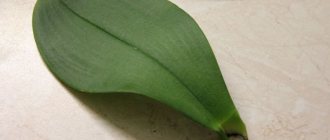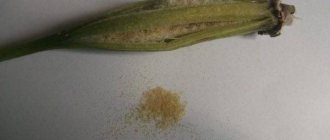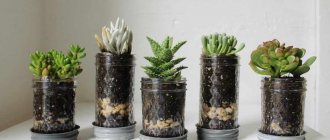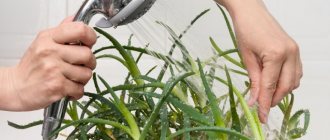Phalaenopsis are beautiful representatives of the orchid family, whose flowers resemble butterflies, and the number of their hybrids is very difficult to count. These are monopodial epiphytes, with an average height of up to 30 centimeters. The leaves are wide and leathery. There can be from 5 to 7 flowers, the variety of their shades is amazing.
Phalaenopsis also grow an aerial root system. In this article we will talk about replanting Phalaenopsis orchids at home.
Drainage for orchids
Let's learn more about drainage for orchids. A drainage layer or drainage is a layer of inert, water-permeable material that is placed on the bottom of a pot or other container with a plant to quickly drain excess water during watering.
Orchids do not always need drainage.
Various materials can act as drainage, such as:
- Pebbles;
- Or shards;
- Expanded clay is most often used.
Does an orchid need drainage? Based on the above definition, drainage is used when the pot is filled with a fine-grained substrate. Orchids are usually planted in a substrate based on tree bark. Such mixtures, as a rule, consist of components of a large fraction, which allows the substrate to pass air and water quite freely.
However, each composition of the mixture can be different from each other, and if we plant Phalaenopsis exclusively in coarse pine bark, then the presence of drainage here is absolutely useless, since the substrate easily allows all the water to pass through, so such pots are often soaked in basins with water rather than watered above.
It’s another matter if the orchid is terrestrial - it requires a heavier, nutritious substrate, therefore, the presence of a drainage layer is quite justified, since it will facilitate the outflow of excess water from the pot after watering.
Therefore, the answer to the question: “Do orchids need drainage?” is ambiguous and relative, it depends on what kind of substrate and pot are used :
- Relatively heavy, in a pot with solid walls or a flask (drainage is needed);
- Or light, in a perforated pot with holes (no drainage needed).
Advice! Before use, test the purchased or home-prepared mixture for water passage. Based on your observations, draw conclusions about the need for a drainage layer in the plant pot. Always use a pot with a hole in the bottom. There is no need to make holes in the pots.
In some cases, if transparent pots, glass vases or flasks are used, the drainage layer may consist of multi-colored pebbles and serve a purely decorative function without providing any practical benefit.
You can also observe in flower shops that orchids have no drainage . This fact is also proof that orchids thrive without drainage.
Care after transplant
After the Phalaenopsis orchid transplant is completed, it requires specific care.
Temperature and lighting
The temperature regime is selected in such a way as not to overdry the flower, but also not to overcool it, because this can lead to wilting of the leaves and atrophy of the roots.
The regime of 25-28 degrees during the day and 18-25 at night is ideal for Phalaenopsis.
Important! To adapt the flower to new conditions, daily temperature changes are created.
The amount of light is also very important for the period after the move. The flower is transferred to the shade and protected from direct sunlight.
Watering
You can carry out the watering procedure after transplantation in a few days. This depends on how much the root system dried out during the move. If the transplant is carried out after flowering, then perhaps the Phalaenopsis enters a resting phase, during which care differs from everyday care. The frequency of watering is reduced, and the temperature also becomes lower.
In this article, we talked about how to replant phalaenopsis and provided step-by-step instructions for replanting a Phalaenopsis orchid.
Kinds
Expanded clay
A lightweight, porous building material obtained from clay shale . Expanded clay may have:
- Various shapes and fractions;
- Inert;
- Durable;
- And very accessible.
Many experts use expanded clay for orchids.
These positive qualities have made expanded clay the most popular material for drainage in floriculture. It has no significant negative properties.
Styrofoam
Roughly speaking, it is a foamed polymer . Foam has:
- A light weight;
- Non-toxic;
- Does not create favorable conditions for the development of algae and fungi.
From a large piece of polystyrene foam you can obtain fragments of the size required in a particular case. it degrades over time when exposed to sunlight . Looks untidy in a pot. In general, it is inferior to expanded clay in terms of durability and practicality.
River pebbles, pebbles
This material is practical on a par with expanded clay . Heavy weight will prevent accidental knocking over of a large, sprawling plant.
Instead of expanded clay, you can use pebbles or pebbles.
Also pebbles:
- Very decorative;
- And it has a very attractive appearance, which will help create an accent in a potted plant.
Advice! Make sure that the rock you collect from the river does not contain lime. This is very easy to check - drop vinegar on the surface of the fragment. Hissing and the appearance of foam indicates that the rock contains calcium carbonate, which is unacceptable.
Crushed stone, pieces of brick
Brick fragments are quite useful materials for drainage if you don’t have expanded clay or pebbles at hand. The positive side is that crushed stone and brick can be found in the city on the street or at any construction site/abandoned site, that is, you can get it yourself without financial expenses. A negative property is the low decorativeness of the material.
Crushed stone consists of limestone and contains calcium carbonates, which is unacceptable.
Shells
A poorly applicable material, since the shells primarily consist of limestone , which is unacceptable for the reasons stated above. Shells can also be randomly placed with the inside facing up and obstruct the flow of water.
Also, decorating pots with epiphytes with shells of underwater creatures, especially marine ones, is at least absurd from an aesthetic point of view .
Substrate, soil
When replanting, it is not recommended to change the entire substrate so that the orchid does not get sick . When completely replacing the soil mixture, there is a sharp change in the microchemical composition to which the roots of the flower are accustomed, so it is better to leave a small part of the old soil (unless it is diseased, of course) and add fresh bark.
A high-quality substrate does not smell of mold, is breathable, moisture-absorbing and consists mainly of bark.
A substrate containing peat is not suitable for orchids. The roots in it can easily rot. Moss, which is often added to the soil mixture, is also superfluous, since it retains moisture for a long time. It needs to be added a little on top and replaced with a new one three times a year.
You can prepare the substrate yourself. For this:
- Take pieces of pine bark (you can buy it). Mandatory condition: it must be without resin and without wood.
- Clean the bark from unsightly and rotten areas with a knife. The size of the pieces should be 1–1.5 cm. Cut large pieces with pruning shears.
- Boil the bark for 2-3 minutes (stirring). Then drain the water, add fresh water and boil again.
- Drain and dry the bark in a low oven (don't burn it!) or on parchment paper. If you use the bark right away, there is no need to dry it completely.
- Add birch charcoal to the bark (you can also buy it). Proportion 4:1.
Do not use polystyrene foam and balsa wood, which are recommended by some, these are completely unnecessary elements! If you want to “dilute” the substrate, then it is better to use expanded clay.
Even if you plant phalaenopsis in bark alone, it will be better than in many purchased substrates, which are too overloaded with peat, moss and all sorts of small fractions. Purchased substrates of this kind are more suitable for growing milkweed. Of the ready-made soils, the Seramis mixture produced in Germany has proven itself very well.
What substances are inappropriate?
- Eggshell. Along with mollusk shells, it contains large amounts of calcium and other trace elements. Use as drainage is unacceptable;
- Dry leaves. As the layer of dry leaves deteriorates and decomposes, it will increasingly impede the outflow of water, which directly contradicts the purpose of drainage;
- Tree bark. It is already part of the orchid substrate. Pine, spruce or oak bark of a large fraction measuring 2-3 cm can be used as drainage, but it is better to put: Expanded clay;
- Pebbles;
- Or polystyrene.
- Mold;
Gribov;
It is better to find another use for the shell ;
Under no circumstances should marble chips be used instead of drainage.
General provisions
Immediately after purchase, or during a certain period of flower development, there comes a time when the pet needs to be transplanted. Phalaenopsis transplantation is carried out for several reasons:
- We are replanting Phalaenopsis because more than 2 years have passed since the last transplant. Orchids of this type are usually replanted every few years in order to give the flower the opportunity to grow and develop.
- The soil has become compacted and no longer fulfills its functions.
- Saline soil due to poor water quality.
This is what a good non-salted substrate should look like.
Good non-salty substrate
The substrate has many functions, many of which are vital for beautiful orchids. If the substrate with the flower no longer allows water to pass through and does not provide sufficient air circulation, then it must be changed and the orchid replanted.
Reproduction
When carrying out the breeding procedure for your pet, transplanting it is an excellent hygienic and convenient aesthetic solution. After dividing the bush, for example, for the remaining part it would be a good solution to update the conditions and plant a new plant.
Diseases and pests
All parts of the plant are affected, as a result of which only transplantation with sanitation can save it. Diseases often occur due to improper care and are a consequence of decreased soil quality. Transplanting Phalaenopsis at home solves this problem.
Replanting after flowering
The time when you can replant a flower is individual, but this is rarely done.
Growing orchids in expanded clay
It is an experimental substrate for orchids. Most experts reject the use of expanded clay as a substrate, however, there is evidence and experience of successfully growing phalaenopsis on this building material.
Moreover, according to reviews from flower growers, plants planted in expanded clay feel much better than those growing in pine bark . In addition, expanded clay does not degrade like pine bark, which makes it a very durable “substrate”; plants practically do not require replanting. The downside is the need to feed the plants.
What to do if the roots grow upward and come out?
Roots on top of the substrate, growing vertically to the surface, are normal for members of the orchid family. However, if this spoils the aesthetic appearance of the specimen, then they do not grab the knife, but reconsider the conditions of agricultural technology.
Increased growth of air processes is evidence of:
- incorrectly selected substrate components;
- soil alkalization;
- salting the contents of the pot;
- sealing of individual components.
Interesting! Roots coming out of the drainage holes indicate that the flowerpot is cramped and clearly requires replanting.
How to prepare drainage at home?
The material that you plan to use as drainage should be prepared and prepared in advance . It should be:
- Clean;
- Dry without traces of mold;
- And fungi.
It is advisable to disinfect it before use by calcining it in the oven. This applies not only to orchids, but in general to all plants that you replant. If necessary, place a small amount of drainage material at the bottom of the pot, necessary for the fraction of water to pass through easily, then you need to carefully place the plant in the pot, filling the free space with substrate.
Do I need to prune if there are a lot of them?
Aerial roots are an indispensable attribute of any orchid. They perform a supporting function and provide the plant with nutrients and water. Therefore, only worn-out or clearly diseased elements should be removed. Healthy ones do not prune, but adjust the frequency of watering:
- few or no aerial roots - increase the frequency of watering;
- 4-5 aerial shoots - watering is left at the same level;
- a lot (more than 7-8 in one pot) - reduce the frequency of watering.
If too many aerial roots appear, correct measures should be taken immediately to ensure the plant receives proper care.
5/5 — (1 vote)
Soil preparation
The unusual root system of most plants of the orchid family requires special soil. The main requirements for it are:
- breathability;
- moisture absorption;
- the ability to hold a flower in an upright position.
Traditionally, the basis of the substrate is made up of fragments of tree bark in the form of small, medium or large squares. Sometimes it is replaced with coconut shell particles. Ready-made substrate for planting orchids can be purchased in special stores or made independently. Its composition looks something like this:
- bark cut from a lying tree and cut into medium-sized squares with pruning shears;
- charcoal or activated carbon;
- coconut fiber;
- sphagnum moss;
- expanded clay or pumice.
Attention! The purchased substrate does not require processing.
If necessary, you can add fir cones, fern roots, humus, and peat. To prevent unwanted insects and microorganisms from appearing in the homemade substrate, it should be pre-sterilized. Suitable acidity for the substrate is important. Ideally, it should be at a pH level of 5.5 - 5.6. Exceeding the norm will cause the plant to stop absorbing iron and its leaves will begin to turn yellow and die.
Is it possible to plant a flower in ordinary soil?
When planting epiphytes, ordinary soil cannot be used as a substrate. Due to the high density of such soil, air circulation in it is minimal. The light transmission of the earth is also zero. Such conditions are detrimental to the root system of epiphytes, and therefore to the plants themselves. However, for terrestrial orchids that have a common root system, the ground will be a completely suitable option.
Using expanded clay as drainage
Any flower living in a pot needs drainage to control moisture levels. Orchid plants are no exception. Expanded clay has always been considered the best option for this. It has its advantages, such as environmental friendliness and hygroscopicity, and disadvantages:
- possible increase in substrate acidity;
- gradual destruction of drainage;
- absorption of not only excess, but also necessary water for the flower.
Expanded clay can also be replaced with other materials. Pebbles, pumice, crushed stone, gravel, ceramic shards, foam plastic or broken bricks do an excellent job of this function.
Application of hydrogel
This is a polymer that comes in the form of multi-colored balls or grains. Its functionality is to absorb a large amount of water and gradually release it to the roots of the plant. Despite its visual attractiveness, hydrogel has many disadvantages:
- does not allow oxygen to penetrate to the root system;
- after some time, mold forms on the balls;
- is not subject to any treatment for the purpose of disinfection.
Temporary placement of a flower in hydrogel is allowed, for example, to decorate a gift. If you leave the plant in such conditions for a long time, it will certainly die. Therefore, when receiving or purchasing an orchid placed in multi-colored balls, it should be transplanted into a more suitable substrate as quickly as possible.










